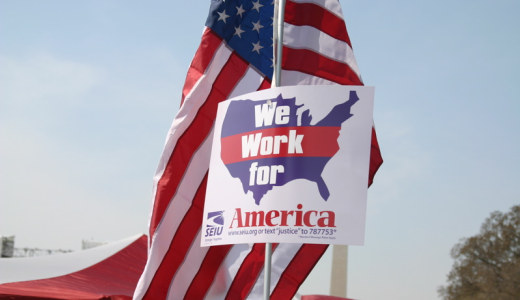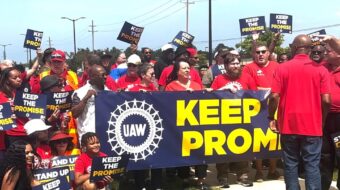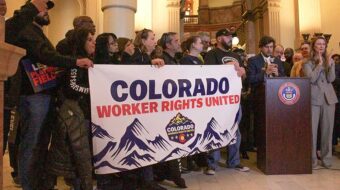
Leaders of the AFL-CIO and a number of Change to Win unions took part in the enormous March 21 immigration reform rally in Washington, arguing that fairer treatment of both documented and undocumented immigrant workers is essential to the struggle for all workers’ rights.
The following day, AFL-CIO President Richard Trumka announced his federation’s support for the DREAM Act, which would allow millions of undocumented young people who have been in the country for more than five years to go to college and gain permanent resident status.
The only winners in attacks on immigrants are the big corporations, AFL-CIO Executive Vice President Arlene Holt Baker told Sunday’s rally.
The current immigration system “is benefiting the very same corporate giants who destroyed our economy,” she said. “It is allowing those corporations to exploit workers by underpaying them, or not paying them at all, simply because of their immigration status. As long as employers have a pool of workers who are too scared to complain, those corporations will continue to profit and workplace standards will continue to go down.”
The support of labor is a significant boost for the immigration reform movement for a number of reasons. The most important may well be the organized fighting power of the labor movement itself, which showed its strength most recently in the fight for health care reform.
Labor’s involvement will also help to take the air out of a major anti-immigrant talking point, the claim that immigration is bad for American workers. Immigration reform advocates counter that allowing the millions of undocumented workers in the United States official status will automatically give them the same protections American workers have: minimum wage, Social Security, and the right to form a union. This will, in turn, create an upward pressure on the wages and benefits of all workers in the U.S. In addition, it will stimulate the economy: undocumented immigrants are some of the poorest people in the U.S., and extra wages will boost their purchasing power, creating a ripple effect.
Further, economists argue that, despite the current economic crisis, long-term trends point to the United States needing more workers. According to Barry Bluestone, dean of the School of Public Policy and Urban Affairs at Northeastern University and author of the new report, “After the Recovery,” a labor shortage could take hold in the United States by 2018, with over 5 million vacancies. If these vacancies are not filled, the cost to the economy could be as much as $3 trillion from 2018 through 2023.
Labor’s official endorsement of Sunday’s rally, as well as a number of pro-immigrant-rights rallies in the past few years, including the Immigrant Workers Freedom Ride in 2004, represents the continued progressive evolution of the labor movement’s policy towards immigrant workers, which began in the 1990s with the election of John Sweeney as AFL-CIO president.
The AFL-CIO is fighting for legalization for the undocumented, an independent commission to assess and manage future immigration based on real needs and real labor market shortages, a secure and fair immigrant worker authorization process, and more rational control over the borders. The labor federation is adamant that temporary worker programs, likened by many to the exploitative bracero programs of the past, be improved and not expanded.
Much of the crowd – estimated in the hundreds of thousands – at the March for America came with their unions. The Service Employees (SEIU) alone mobilized more than 5,000 members, from as far away as California, to attend. Other unions mobilized similar numbers, and the AFL-CIO, SEIU, Unite Here and others were part of the coalition sponsoring the march.
Photo: An SEIU sign held aloft at Sunday’s March for America. http://www.flickr.com/photos/luckywhitegirl/ / CC BY 2.0












Comments